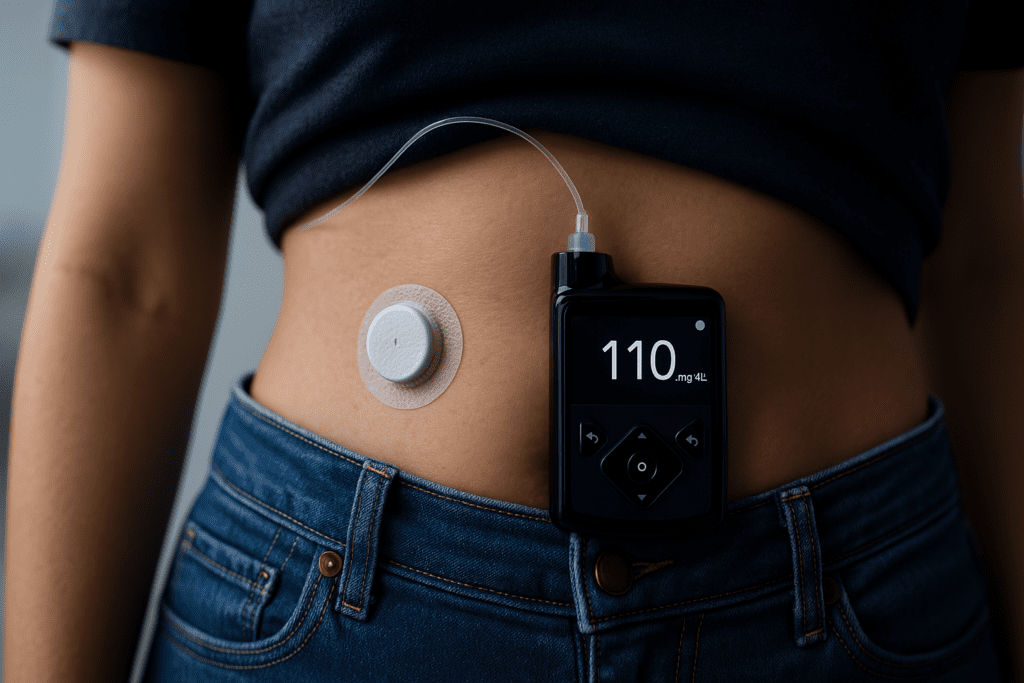Understanding the Rise of Diabetes in Young Adults
Diabetes, once considered primarily an adult-onset disease, has undergone a striking epidemiological shift in recent decades. Increasingly, young adults and adolescents are receiving diagnoses that were once rare at such an early age. The growing prevalence of both type 1 and type 2 diabetes in this younger demographic is prompting urgent research, particularly into effective prevention and treatment strategies tailored to the unique physiological and psychosocial needs of these patients. This shift is particularly notable in the case of teenage diabetes, which encompasses not only autoimmune-driven type 1 diabetes but also the lifestyle-related rise in early-onset type 2 cases.
You may also like: Breakthroughs in Current Diabetes Research: What the Latest Studies Reveal About Treatment and Prevention
Medical experts now recognize that diabetes in young adults and adolescents poses a unique challenge: early diagnosis leads to longer lifetime exposure to hyperglycemia, increasing the risk of long-term complications like cardiovascular disease, neuropathy, and retinopathy. Consequently, research is focusing on not only metabolic control but also interventions that integrate technology, behavioral science, and even genetics to personalize care. Understanding these developments is critical as the global burden of youth-onset diabetes continues to rise.
The Complexity of Teenage Diabetes and Its Diagnosis
The term “teenage diabetes” broadly refers to cases diagnosed during adolescence, typically between ages 10 and 19. However, within this group, clinicians encounter a diverse array of diabetes types, including autoimmune type 1 diabetes, which is most common in younger children, and type 2 diabetes, which has increased in prevalence among teenagers due to rising rates of obesity and sedentary lifestyles. Accurately distinguishing between the two types is essential but sometimes difficult, as early-stage presentations can overlap.
Type 1 diabetes in teens typically presents with sudden symptoms, including excessive thirst, unexplained weight loss, and fatigue. In contrast, type 2 diabetes in this age group may initially go unnoticed, as the symptoms develop more gradually and may be misattributed to general adolescent fatigue or hormonal changes. Genetic predisposition plays a significant role, particularly in cases of diabetes from birth, also known as neonatal diabetes, which is caused by rare monogenic mutations and typically presents within the first six months of life.
Recent studies have highlighted the diagnostic importance of autoantibody testing and C-peptide levels, allowing clinicians to better distinguish between autoimmune and insulin-resistant forms. Advances in genetic testing also offer insight into cases where diabetes is suspected to have been present since birth, providing clarity for individuals who may have been misdiagnosed and undertreated for years.

Technological Innovations in Managing Type 1 Diabetes in Teens
Among the most promising developments in treating type 1 teens is the rise of continuous glucose monitoring (CGM) systems and automated insulin delivery (AID) devices. These technologies represent a major breakthrough by allowing real-time glucose tracking and more precise insulin dosing, which are crucial for managing blood sugar fluctuations in this age group. Adolescents often struggle with the unpredictability of hormonal shifts, stress, and irregular eating patterns, making consistent glycemic control particularly challenging.
Research has shown that CGM devices not only improve A1C levels but also enhance quality of life by reducing the need for frequent finger pricks and alleviating the burden of constant disease management. The psychological benefits are also noteworthy. Teenagers using CGM and AID systems report lower levels of diabetes-related distress and greater autonomy, contributing to better adherence and long-term outcomes.
In addition to hardware advances, digital health platforms and mobile apps are helping teens track meals, physical activity, and emotional triggers that impact blood glucose levels. These tools can integrate seamlessly with CGMs, offering personalized insights and empowering young users to better understand their unique patterns. Emerging research suggests that such comprehensive, tech-enabled approaches may be especially valuable in improving self-management skills in teenagers, a demographic often characterized by fluctuating motivation and inconsistent routines.
Tailoring Treatment Strategies for Diabetes in Young Adults
Managing diabetes in young adults demands a distinct clinical approach, as this group faces unique life transitions that complicate disease management. The shift from pediatric to adult care can be jarring, particularly when it coincides with other major changes such as college, employment, and shifts in social support networks. Research has shown that this transition phase is associated with increased risk for poor glycemic control, lapses in follow-up care, and heightened emotional burden.
To mitigate these risks, healthcare systems are adopting transitional care models designed to ease the handoff between pediatric and adult endocrinology. These programs emphasize patient education, self-management training, and proactive psychosocial support. Additionally, behavioral interventions like cognitive behavioral therapy (CBT) are being integrated to address anxiety and depression, which disproportionately affect individuals with diabetes in young adulthood.
Recent advancements in pharmacotherapy have also played a key role. While insulin remains the cornerstone of type 1 diabetes management, new adjunctive therapies are being explored to improve outcomes. For instance, SGLT2 inhibitors, traditionally used in type 2 diabetes, are now being studied for their potential to reduce glucose levels and insulin requirements in type 1 cases. Clinical trials are underway to assess their safety and efficacy in younger populations, with preliminary data suggesting that they may offer metabolic and cardiovascular benefits when used under close medical supervision.
The Genetic Landscape of Diabetes From Birth
The phrase “diabetes from birth” refers to a rare but increasingly studied category of diabetes caused by single-gene mutations, known as monogenic diabetes. This condition differs markedly from both type 1 and type 2 diabetes in its etiology and clinical presentation. Unlike autoimmune or insulin-resistant mechanisms, monogenic forms typically result from defects in insulin production pathways and often respond to oral sulfonylureas rather than insulin injections.
Recent breakthroughs in genetic sequencing technologies have led to more accurate and earlier diagnoses of neonatal diabetes. This progress is crucial because many cases are misdiagnosed as type 1 diabetes, leading to years of unnecessary insulin therapy. Identifying the precise genetic mutation allows for personalized treatment and, in some cases, a dramatic improvement in quality of life when insulin therapy is replaced with oral medication.
Moreover, understanding the molecular basis of these mutations has wider implications for the diabetes research community. For example, the study of KCNJ11 and ABCC8 gene mutations not only informs clinical care but also sheds light on the basic mechanisms of insulin secretion and pancreatic beta-cell function. These insights could lead to novel drug targets that benefit broader patient populations beyond those diagnosed with diabetes from birth.

Lifestyle Interventions for Teenage and Young Adult Diabetes Management
While pharmacologic and technological advancements are important, lifestyle remains a foundational pillar in managing both teenage diabetes and diabetes in young adults. Nutrition education tailored to the preferences and cultural backgrounds of young people is essential, as many standard dietary recommendations fail to engage this age group meaningfully. New research suggests that interactive, peer-supported programs are more successful in fostering lasting behavioral change compared to traditional didactic approaches.
Physical activity is another cornerstone of effective management, yet it presents challenges in adolescents and young adults who may lack motivation or structured routines. Studies are increasingly focusing on identifying exercise regimens that align with the interests of youth, such as dance, team sports, or even gamified fitness apps. These approaches not only improve insulin sensitivity and cardiovascular health but also promote emotional resilience, which is critical in chronic disease management.
Additionally, sleep and stress management are gaining recognition as key lifestyle factors that significantly affect glycemic control. Emerging data indicates that sleep disturbances and chronic stress exacerbate insulin resistance and glycemic variability, particularly in young people undergoing academic and social pressures. Interventions such as mindfulness training, cognitive behavioral therapy, and even digital mental health platforms are being evaluated for their ability to support emotional well-being alongside metabolic outcomes.
Health Disparities and Socioeconomic Barriers in Youth-Onset Diabetes
An important dimension of diabetes in young adults and teenagers is the impact of socioeconomic factors and health disparities. Research consistently shows that minority populations and individuals from low-income backgrounds are disproportionately affected by early-onset diabetes. These groups often face barriers to timely diagnosis, consistent care, and access to the latest technologies, such as continuous glucose monitors and insulin pumps.
For type 1 teens and those with early-onset type 2 diabetes, these disparities can result in poorer glycemic control and higher rates of complications. Social determinants such as food insecurity, limited health literacy, and lack of transportation to medical appointments compound the difficulty of managing a complex chronic illness. Public health initiatives aimed at increasing access to care and reducing systemic barriers are essential to leveling the playing field for these vulnerable populations.
Policy-driven solutions are beginning to take shape. Programs that offer subsidized CGM devices, culturally relevant diabetes education, and school-based health clinics are emerging in underserved communities. Furthermore, researchers are calling for greater inclusion of diverse populations in clinical trials to ensure that findings are applicable across different ethnic and socioeconomic groups. Without this inclusivity, innovations in diabetes care risk leaving behind those who need them most.
Immunotherapy and Regenerative Medicine: The Future of Type 1 Diabetes Treatment
One of the most exciting frontiers in diabetes research lies in the potential for immunotherapy and regenerative medicine to modify or even reverse type 1 diabetes. Type 1 diabetes is characterized by autoimmune destruction of insulin-producing beta cells in the pancreas, and traditional management has centered solely on insulin replacement. However, new therapies aim to address the root cause: immune dysregulation.
Clinical trials are now underway exploring agents that modulate the immune response to prevent or delay the progression of type 1 diabetes in at-risk individuals. One promising avenue is the use of anti-CD3 monoclonal antibodies, which target specific T cells responsible for the autoimmune attack. Preliminary results indicate that these agents may preserve beta-cell function when administered in the early stages of disease.
Meanwhile, stem cell research is investigating how to regenerate functional beta cells or replace them through transplantation. Recent breakthroughs in stem cell-derived islet cell production have demonstrated that it is possible to create insulin-producing cells in the laboratory that mimic the function of natural beta cells. Early-stage clinical trials using encapsulated islet cells have shown promising results, with some participants experiencing reduced insulin requirements and improved glycemic control.
These advances, though still experimental, offer hope for a future in which type 1 diabetes could be managed not just through symptom control but through disease modification or even cure. For teenagers and young adults newly diagnosed with type 1 diabetes, the prospect of such transformative therapies represents a beacon of possibility amidst the daily challenges of managing their condition.

Frequently Asked Questions: Breakthroughs in Treating Diabetes in Young Adults and Teenagers
1. How do emotional and psychological factors uniquely affect diabetes in young adults?
Young adults managing diabetes often face a convergence of life transitions, including starting college, entering the workforce, or living independently for the first time. These changes can increase stress, reduce sleep quality, and disrupt routines—all of which negatively impact blood sugar regulation. Research shows that diabetes in young adults is strongly associated with a heightened risk of depression and anxiety, both of which can impair self-care behaviors like consistent insulin dosing or dietary adherence. While emotional support is crucial for all individuals with diabetes, this age group particularly benefits from integrated mental health services and peer mentoring models. Developing personalized stress management plans and incorporating therapeutic interventions like mindfulness training can significantly improve outcomes.
2. What role does early family involvement play in the long-term success of type 1 teens?
When managing type 1 diabetes in teens, active family engagement can serve as a critical protective factor. Teenagers often struggle with independence and rebellion, which may manifest as non-adherence to diabetes care plans. Families that foster open communication and maintain a balance between supervision and autonomy tend to achieve better outcomes. Studies suggest that parental involvement in tasks such as glucose monitoring and meal planning, even when teens appear resistant, contributes to improved A1C levels. As type 1 teens transition into adulthood, gradually shifting responsibility while maintaining supportive oversight can help establish lifelong management habits.
3. Are there emerging dietary approaches specifically designed for teenage diabetes?
Recent nutritional science has begun tailoring dietary frameworks that address both the metabolic and psychological needs of adolescents with diabetes. For teenage diabetes management, low-glycemic, high-fiber meal plans with flexible carb counting have gained popularity for promoting stable blood sugar while accommodating teen lifestyles. Innovations like culturally sensitive nutrition education and digital food tracking apps provide additional layers of support. Some researchers are also investigating the benefits of time-restricted eating patterns for teenagers with type 2 diabetes, though long-term safety in this age group is still under review. Ultimately, involving teens in the design of their eating plans helps build both autonomy and adherence.
4. How does diabetes from birth impact long-term neurodevelopment and cognition?
Children diagnosed with diabetes from birth often face distinct developmental challenges compared to those diagnosed later in life. Persistent hyperglycemia during infancy and early childhood—a critical window for brain development—has been linked to subtle cognitive impairments, particularly in memory, attention, and executive function. Advances in early intervention, such as insulin pump therapy and continuous glucose monitoring, aim to minimize glucose variability during this vulnerable period. Longitudinal studies are underway to better understand the neural implications of diabetes from birth and to develop targeted cognitive training programs. With early diagnosis and proactive care, many children with neonatal diabetes can achieve normal intellectual and academic milestones.
5. What are the social implications of managing diabetes during adolescence?
Managing teenage diabetes often intersects with intense social pressures, including the desire for peer acceptance, body image concerns, and experimentation with risky behaviors like alcohol use. Teens may hide their condition, skip insulin doses, or eat erratically to avoid standing out or feeling different. These behaviors not only compromise glycemic control but can also increase the risk of acute complications such as ketoacidosis. Schools, sports teams, and social groups play a pivotal role in creating supportive environments that normalize diabetes care. Initiatives such as diabetes education for teachers and friends can empower type 1 teens to confidently manage their condition in public and social settings.
6. Are there gender-specific considerations in diabetes in young adults?
Yes, sex and gender play a nuanced role in the manifestation and management of diabetes in young adults. For example, women with diabetes are more likely to experience depression and disordered eating behaviors, which can complicate glycemic control. Hormonal fluctuations due to menstrual cycles, contraceptive use, and pregnancy planning introduce additional layers of complexity for females. Meanwhile, men may be less likely to seek help for psychological distress, potentially delaying essential interventions. Healthcare providers are increasingly encouraged to consider these gender-based differences when tailoring diabetes management strategies, particularly for early-onset cases in this age group.
7. What barriers do healthcare systems face in treating diabetes from birth effectively?
Diagnosing and managing diabetes from birth requires highly specialized knowledge, yet many healthcare systems lack standardized protocols for early identification. Misclassification as type 1 diabetes is common, which can lead to years of unnecessary insulin therapy when oral agents might be more effective. Limited access to genetic testing further compounds this issue, especially in underserved regions. Pediatric endocrinologists are advocating for broader genetic screening panels to be included in neonatal workups for unexplained hyperglycemia. Increasing awareness among general practitioners and pediatricians is also critical for timely referrals and accurate diagnoses of monogenic diabetes in infancy.
8. How is technology reshaping treatment for type 1 teens beyond glucose monitoring?
While continuous glucose monitors are game-changers, the broader landscape of diabetes technology is rapidly evolving. For type 1 teens, new closed-loop insulin delivery systems, often dubbed the “artificial pancreas,” are reducing both the frequency of hypoglycemia and the cognitive burden of disease management. Smart insulin pens with dose-tracking features are also entering the market, enhancing treatment accuracy and providing valuable data for clinicians. In addition, artificial intelligence is being used to personalize insulin dosing algorithms based on activity, nutrition, and stress patterns. These innovations are especially impactful for teenagers, whose physiology and daily routines can fluctuate dramatically.
9. What are some overlooked complications of poorly managed teenage diabetes?
Beyond the well-documented risks of nephropathy and retinopathy, poorly managed teenage diabetes can have less visible but equally serious consequences. For instance, autonomic neuropathy affecting the gastrointestinal system can lead to chronic nausea and gastroparesis, severely impacting quality of life. Psychological complications, including diabetes burnout and social withdrawal, often emerge silently and are underdiagnosed. Emerging research also suggests that early vascular changes can begin in adolescence, raising lifetime cardiovascular risk. These findings underscore the need for a holistic care model that addresses not just glucose metrics, but also the broader physical and mental health impacts.
10. What future innovations hold the most promise for transforming diabetes in young adults?
Several cutting-edge technologies and therapies are poised to reshape how diabetes in young adults is treated. Personalized medicine, including microbiome profiling, may soon enable diet and drug recommendations tailored to an individual’s gut flora and metabolic response. Immunotherapies designed to halt or slow the autoimmune destruction of beta cells offer hope for altering the course of type 1 diabetes. Gene editing technologies like CRISPR are also being explored for correcting monogenic mutations responsible for diabetes from birth. Finally, digital twins—virtual models of patients that simulate disease progression and treatment response—could become invaluable tools for real-time decision-making. These innovations, while still in development, reflect a future where treatment is increasingly proactive, personalized, and precise.
Conclusion: A Transformative Era in Diabetes Research for the Young
As the global prevalence of youth-onset diabetes continues to rise, the scientific community is responding with an unprecedented surge in research and innovation. From genetic decoding of diabetes from birth to the integration of cutting-edge technology for type 1 teens and young adults, the landscape of care is evolving rapidly. Importantly, this transformation is not merely about new medications or devices but about rethinking the entire model of diabetes management to reflect the realities of young people living with a lifelong condition.
By tailoring treatments to the developmental, emotional, and social contexts of young adults and adolescents, healthcare providers are better equipped to deliver care that is both effective and compassionate. Emerging therapies in immunology and regenerative medicine offer new hope for altering the course of disease rather than simply managing symptoms. Meanwhile, public health strategies aimed at closing the gap in access to care are helping ensure that the benefits of innovation reach all segments of the population.
In this transformative era, addressing teenage diabetes, understanding the genetic roots of diabetes from birth, and innovating solutions for diabetes in young adults have become top priorities in medical research. Each new breakthrough not only deepens our understanding of these conditions but also moves us closer to a future where young people diagnosed with diabetes can live healthier, more empowered lives. With continued investment, collaboration, and compassion, the momentum in diabetes research promises a better tomorrow for the next generation of patients.
early-onset diabetes research, adolescent blood sugar control, youth metabolic health, pediatric endocrinology advancements, insulin pump technology, CGM for teenagers, genetic testing for diabetes, monogenic diabetes treatment, mental health in young diabetics, lifestyle interventions for adolescents, digital health tools for teens, autoimmune diabetes therapy, managing diabetes in college students, transition care for young diabetics, innovative diabetes therapies, personalized diabetes treatment, school support for diabetic teens, dietary strategies for youth diabetes, tech-assisted diabetes care, emotional wellness and chronic illness
Further Reading:
New options for treating type 2 diabetes in kids and teens
How does diabetes affect children and teenagers?
Diabetes: The Top Discoveries and Developments of 2022
Disclaimer
The information contained in this article is provided for general informational purposes only and is not intended to serve as medical, legal, or professional advice. While MedNewsPedia strives to present accurate, up-to-date, and reliable content, no warranty or guarantee, expressed or implied, is made regarding the completeness, accuracy, or adequacy of the information provided. Readers are strongly advised to seek the guidance of a qualified healthcare provider or other relevant professionals before acting on any information contained in this article. MedNewsPedia, its authors, editors, and contributors expressly disclaim any liability for any damages, losses, or consequences arising directly or indirectly from the use, interpretation, or reliance on any information presented herein. The views and opinions expressed in this article are those of the author(s) and do not necessarily reflect the official policies or positions of MedNewsPedia.


